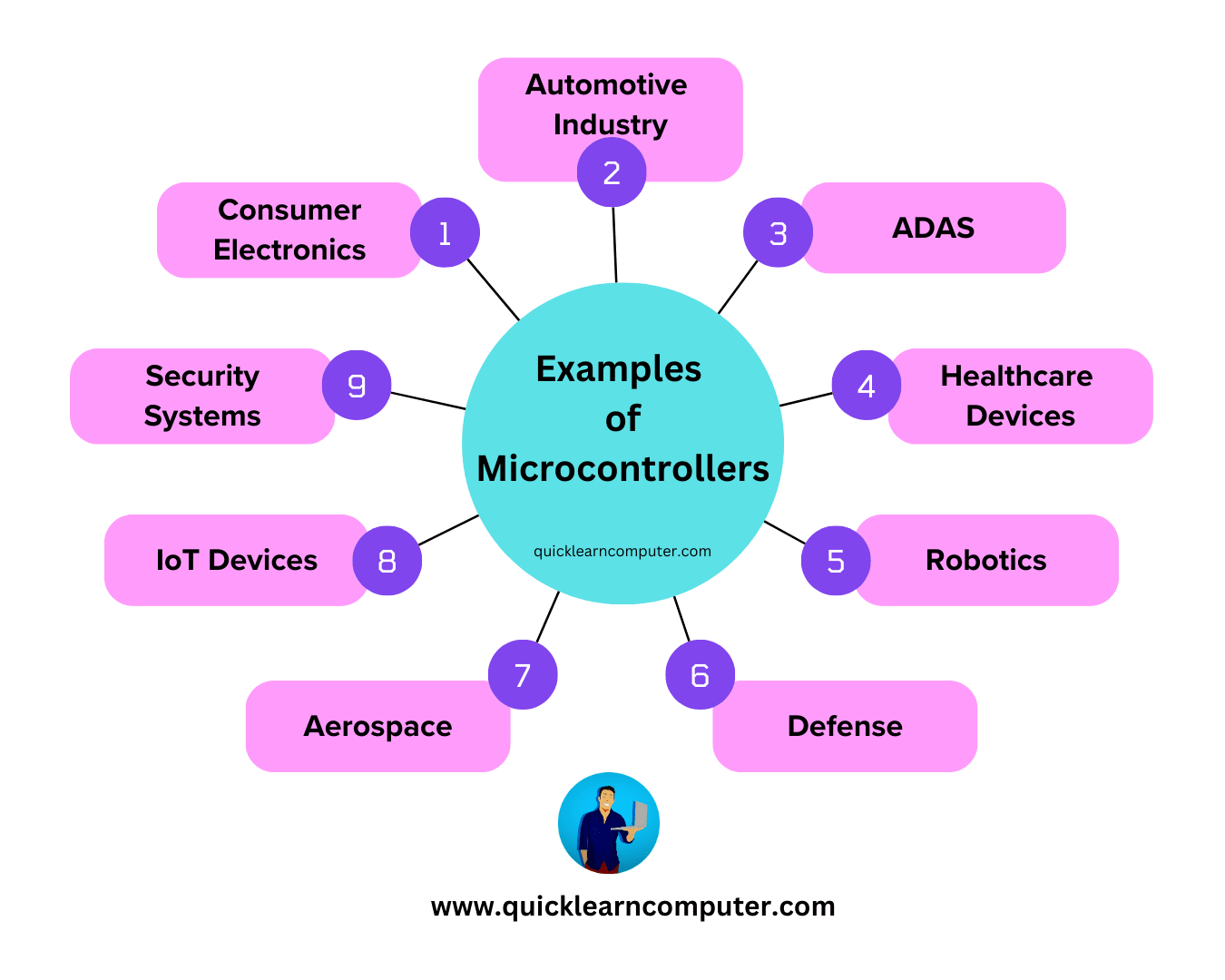Microcontrollers are the backbone of modern electronics, embedded in almost every smart device we use today.
These compact integrated circuits (ICs) are programmed to perform specific tasks efficiently, making them indispensable in various industries.
From consumer electronics to medical devices and automotive systems, microcontrollers have revolutionized technology, enabling automation and enhancing functionality.
This article explores the applications of microcontrollers in different sectors, shedding light on their significance in the modern world.
What is a Microcontroller?
A microcontroller is a compact integrated circuit designed to perform specific tasks within electronic devices. It consists of a processor, memory, and input/output peripherals.
Uses & Applications of Microcontrollers
There are various most notable applications and uses of microcontrollers in everyday life, which are given below.

1. Consumer Electronics
Microcontrollers play a pivotal role in everyday gadgets, ensuring seamless operation and enhanced user experience. Some key applications include:

Smartphones and Tablets – Managing battery life, touchscreen operations, and connectivity features.
Smart Home Devices – Powering IoT-enabled devices like smart thermostats, security cameras, and smart lighting systems.
Wearable Technology – Found in fitness trackers and smartwatches, monitoring health metrics and enabling Bluetooth connectivity.
Remote Controls and Gaming Consoles – Enhancing response time and wireless connectivity.
2. Automotive Industry
The automotive sector extensively uses microcontrollers to improve safety, efficiency, and automation. Key applications include:
A) Engine Control Units (ECUs)
Microcontrollers regulate engine performance by managing fuel injection, emission control, and ignition timing, optimizing fuel efficiency and reducing environmental impact.
B) Advanced Driver-Assistance Systems (ADAS)
Modern vehicles incorporate microcontrollers for collision detection, automatic braking, and adaptive cruise control, ensuring safer driving experiences.
C) Infotainment Systems
Microcontrollers enhance in-car entertainment by managing touchscreens, navigation systems, and audio-visual controls.
3. Medical and Healthcare Devices
The medical field benefits immensely from microcontroller-driven devices, offering precise monitoring and automation. Common applications include:

Medical Imaging Systems – Found in MRI and CT scanners, processing complex imaging data.
Portable Medical Devices – Used in glucometers, digital thermometers, and blood pressure monitors.
Implantable Medical Devices – Microcontrollers are crucial in pacemakers, ensuring proper heart rate regulation.
Automated Drug Delivery Systems – Managing insulin pumps and infusion devices.
4. Industrial Automation and Robotics
Factories and manufacturing units leverage microcontrollers to enhance efficiency and precision. Applications include:
Programmable Logic Controllers (PLCs) – Used in industrial automation to control assembly lines and robotic arms.
Process Control Systems – Regulating temperature, pressure, and humidity in industrial plants.
Robotics and AI Integration – Enabling intelligent robots to perform complex tasks in hazardous environments.
5. Aerospace and Defense
Microcontrollers are extensively used in defense and aerospace technologies to ensure accuracy, reliability, and automation. Key applications include:

Navigation Systems – Found in GPS-enabled military equipment and space probes.
Autonomous Drones – Used in surveillance, target tracking, and reconnaissance missions.
Missile Guidance Systems – Ensuring precise targeting and trajectory control.
Flight Control Systems – Managing aircraft stability and avionics.
6. Communication and Networking
Microcontrollers support modern communication systems by handling data transmission, encryption, and network protocols. Their applications include:
Wireless Communication Devices – Found in routers, modems, and Bluetooth/Wi-Fi modules.
IoT Devices – Enabling seamless communication between smart devices and cloud services.
Telecommunication Infrastructure – Supporting base stations and satellite communication systems.
7. Home Automation and Security Systems
Smart homes and security systems rely on microcontrollers to offer automation and security enhancements. Examples include:
Smart Door Locks – Providing keyless entry through fingerprint and RFID technology.
Home Surveillance Systems – Enabling real-time monitoring via motion detectors and CCTV cameras.
Smart HVAC Systems – Regulating heating and cooling based on occupancy and weather conditions.
Frequently Asked Questions (FAQs)
1. How do microcontrollers differ from microprocessors?
Microcontrollers are self-contained units with built-in memory and peripherals, used in embedded systems. Microprocessors, on the other hand, require external hardware components and are typically used in computers and more complex systems.
2. What are the advantages of using microcontrollers?
Microcontrollers offer several advantages, including:
Low power consumption
Compact size
Cost-effectiveness
Efficient performance for dedicated tasks
3. Where are microcontrollers commonly used?
Microcontrollers are widely used in:
Consumer electronics (smartphones, smart home devices, wearables)
Automobiles (ECUs, ADAS, infotainment systems)
Medical devices (pacemakers, blood pressure monitors, imaging systems)
Industrial automation (PLCs, robotics, process control systems)
Communication systems (Wi-Fi modules, IoT devices, routers)
4. What is the future of microcontroller technology?
The future of microcontrollers lies in AI integration, enhanced IoT capabilities, lower power consumption, and greater processing power for more sophisticated applications in smart cities, healthcare, and automation.
Conclusion
Microcontrollers have transformed the world, enabling automation, efficiency, and precision across various industries.
From consumer electronics to healthcare, automotive, aerospace, and industrial automation, these compact computing units continue to revolutionize technology.
As advancements in microcontroller technology progress, we can expect even more innovative applications, paving the way for a smarter and more connected world.